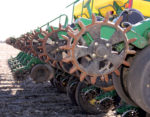Advertise Follow Us
Items Tagged with 'crop emergence'
ARTICLES
No-Till Notes
What You Can Learn from a Post-Planting Scouting Trip
Scouting fields after planting is over can help no-tillers learn what tweaks might be needed for their planting operations or weed management programs.
Read More
The Final Act: Closing The Seed Slot
Field variability, tougher trash and growers’ early-planting ambitions drive improvements to planter closing wheels used in no-till fields.
Read More
Consider Gypsum Applications To Improve No-Till Soil Structure
Benefits could include better aeration and water infiltration and less crusting, leading to enhanced crop emergence and stronger roots.
Read More
Ridge Till Continues To Gain Popularity
The winner of the Phoenix Rotary Equipment Ltd. conservation tillage essay contest explains the benefits of ridge tilling.
Read More








